The first generation of my family to come from Turkey, my grandmothers and my aunties, used to sit and rest a bit in the afternoon. After preparing dinner and finishing their housework, they traded bits of gossip about the community and themselves (char lashon) with a cup of Turkish coffee and a biscotio in hand. These circular biscuits topped with sesame seeds, are not sweet like cookies, nor are they savory. They are perfect for dunking in coffee, espresso, or even tea. Biscotios keep a long time in an airtight container and are very portable. It is good to keep a couple in a small plastic bag in the bottom of your handbag, just in case. I guess we all turn into our mothers or fathers as the case may be, eventually.
Yield 80 biscotios
Serves 40 to 80
4 extra largeeggs
1/2 cup orange juice, I prefer fresh squeezed
1 cup of sugar
3/4 cup oil, safflower or sunflower
2 heaping tablespoons of Masticha (optional)
1 and 1/2 teaspoons ground anise
1/2 teaspoon baking soda
4 teaspoons baking powder
2 tablespoons freshly grated orange peel
½ teaspoon salt
6 cups flour
1 egg, well beaten with a small whisk, in a shallow bowl
1 cup sesame seeds for garnish, in a shallow bowl
Preheat the oven to 350º F. Crack 4 eggs in a glass bowl and check for shells and blood spots. Place eggs in the bowl of a stand mixer and beat on medium for a minute, add 1/2 cup of orange juice. Beat until well blended. With the mixer running on low speed, slowly add 1 cup sugar then, 3/4 cup of oil. Lastly add the Masticha. Continue mixing until very well blended. In a separate bowl combine 1 cup flour with other dry ingredients and orange zest, and then, add it to liquid mix, while the mixer is off. Start mixer on lowest speed for 30 seconds, then raise speed to medium and mix until well incorporated. Turn off mixer again and add the last 5 cups of flour. Start the mixer on the lowest speed until flour begins to incorporate, increase the speed to medium for a couple of moments. The dough should be soft, but not sticky.
Remove dough from mixing bowl, gather it into a ball, and let dough rest for 10 minutes on your work surface. Wood or stone is best. Divide dough into 4 quarters. Wrap 3 pieces in plastic wrap. Roll the remaining piece into a log , about 1 ½ inches in diameter, on a very lightly floured surface. Cut log in 20 even pieces. Roll each piece out to a 4 ½ inch long rope, nick rope on the outer edge at 1/3 inch intervals, creating a design. Draw rope into a circle, and pinch edges together. Arrange your two shallow bowls, one with with beaten egg and one with sesame seeds next to cookie sheets for baking. Line the cookie sheets with parchment paper or a Silpat. Dip each biscotio into beaten egg on one side, and then, sesame seeds, place biscotio on prepared baking sheet, sesame side up. Bake for 15 to 20 minutes until golden in color.
After all biscotios are baked, turn down the oven temperature 200º F. Bake biscotios in oven for 30 minutes until crisp. I turn off the oven after the 30 minutes and leave them sit inside for a couple of hours. Cool them on a rack and then store them in an airtight container. This recipe makes about 80 biscotios.
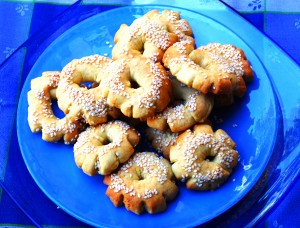
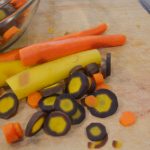
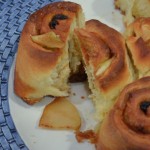
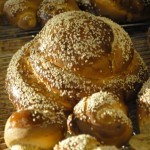
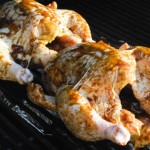
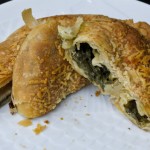
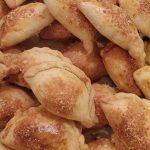
Hi Linda,
Just wanted to let you know I made the biscotio recipe. I couldn’t find the ground anise in the supermarket so I substituted 1 tsp of vanilla. The biscotios are delicious. I am sure I will be making them often. Thanks so much for sharing your recipe.
Hi Norma, you can find the ground spices at some online sources, Try Penzies, Kalustyans, or Surfas. I am glad you enjoyed the biscotios.
Hi Linda! I can’t be completely, absolutely certain that these are the same cookies that my grandmother (she of ‘bee-yeek-oos’ fame from my earlier post) made, but going by the photo you have here, and the ingredients and the way you’ve described them, these very well could be the ones I remember with the same fondness as my beloved bee-yee-koos/burekyas!
They weren’t overly sweet, but they weren’t overly savoury, either – just as you’ve described above. But they were very buttery, with an egg wash on top, and sometimes sesame seeds. What did it for me was the specific way these cookies you have in the photo are diagonally spliced. That’s just the way my grandmother cut her cookies, too. The only difference that I can see between your photo and my memories of them was that the hole in the middle of my grandmother’s cookies were a lot larger…almost bagel-hole size, if you get what I’m trying to describe.
Oh, how I wish you could just cyber-magically send me some of your already-made biscotios for me to sample, so I can tell for sure if they’re the same ones. OMG! What am I saying! I can do that myself, as you’ve so very generously given the recipe! D’oh! I will definitely try this recipe (not to mention the borekas/burekyas/’bee-yee-koos’ recipe) and let you know.
This is such a brilliant, wonderful site and blog, Linda. Thank you so much!
Oh! I just remembered something else about these cookies. They were sort of crunchy and crumbly, but not rock hard. Not ultra melt-in-your-mouth either, but they were amazingly utterly butterly, if memory serves. Do the biscotios you make have that sort of texture? I simply cannot wait to try these recipes out myself.
I was also wondering (your blog has really stirred the cook and baker in me – especially the Greek Sephardic side of me) if there’s a cookbook aimed specifically at Sephardic Jewish culture? With recipes for these and borekas in them, maybe?
I absolutely love this blog, and I’ll of course be trying these recipes (all of them, if I have my way), but I’m a book lover and a cookbook collector, so I was just wondering if you could recommend any really good Jewish/Sephardic Jewish/Greek/Turkish cookbooks (of which I sadly have none in my own collection)
Hi Greekgirl, you are right the biscochios sometimes called biscochikus (little ones) are not rock hard, they are perfect for dunking in coffee or kave’ as we say. They are actually made with oil since they had to be non-dairy so they could be eaten after any meal. In regards to your other question, there are a lot of Sephardic cook books like, Joyce Goldstein’s Sephardic Flavors and Cucina Ebraica, also Aromas of Allepo by Poopa Dweck has Syrian dishes, different then ours but tasty, also try Faye Levy’s books. One more suggestion is Synagouge cook books from various Sephardic shuls. For Purim and Passover I hope to post a lot of stuff and next week I will post another Shabbat dinner. I love all of your comments. Thanks Linda
Hi LInda – I’m just about ready to try your recipe for biscotios de huevo, except that I’m missing three ingredients – that being the masticha (I doubt even that specialty food shop I found the feta cheese in last week would have this, but it’s worth a try to at least ask them) and the ground anise, as well as the orange juice/oranges (which of course I can easily get at my local shop this afternoon). I have a feeling that our local shops here won’t have anise, but maybe the local health food shop might have it (and if they do, it’ll be organic – even better!).
My hubby’s expecting magical things to come out of the oven this weekend, and I don’t want to disappoint. He’s still going on about the borekyas, and can’t wait till I attempt the kolva. I’ll turn him into a Sephardic Irishman yet, LOL
Hi Greek Girl,
I made Linda’s biscotios recipe twice–to rave reviews. The masticha is optional and I did not use it. I couldn’t get ground anise and I used 1 teaspoon of vanilla.
We loved the cookies. Good luck with your baking.
Norma
Hi Norma and Linda – Opinion from the hubby on my first-time-ever biscotios this evening: an 9 out of 10. He said that they were a bit overly eggy, but thinks that’s definitely not due to the fault of the recipe or of my ability to follow the recipe, but that our normal brown Irish eggs (we don’t have white eggs here) are more intense than American eggs, and so perhaps the next batch I make, I could use two eggs instead of four.
Other than that, he absolutely adores them, and told me to put them away lest he devour 10 more before the evening was over! I’d say that’s a ‘result’ and a big ‘thumbs up,’ na?
As for the anise, I was delighted to find it in our local health food shop. It was whole star anise, and so I had to grind it up myself at home (which made the whole baking experience that more exciting and inspiring and fun), but I also added just a drop of vanilla, just bec ause we both are fans of vanilla whenever I bake non-savoury pastries.
I think I also could have rolled the ‘logs’ into smaller logs, as the holes in the rings came out quite small in some cases, when the biscotios were baking (and the dough expanded). That would also explain why the total of biscotios I ended up putting on the baking trays only amounted to 60, not 80. I obviously made them a bit too thick, and used more dough per biscuit than I should have, but….well…I’m sure I’d be forgiven.
But other than that, they taste wonderful, and I’d really like to think that my nunna is looking down from heaven and would have liked these…not as good as hers always were, but then, she’d been making them for decades, and probably learned it from her mother or grandmother…but to me, they brought back all sorts of memories, which is what I’d hoped for from the start of my journey.
I am so pleased with the result, that I cannot wait to make another batch. And at the rate we were munching our way through these, it won’t be long before I make another 60.
Thank you so, so much for this recipe, Linda, and for this brilliant blog (sorry if I sound like a broken record), and Norma, thanks for your suggestion about the vanilla. If ever I can’t find anise, I won’t worry about switching over to vanilla.
HI Greek Girl, I am so happy your biscotios came out great. You will definately get better each time. If you really wany to try the Anise, there are mail order spice stores, but I am sure when my Nona first came to the United States, they couldn’t find half of the stuff they usually cooked with. They probably eventually found anise from the Italians or the Armenians. The food comes out great without or whatever you want to innovate with. Let me know if you need the Spice Store Links.
Some of my favorite cookbooks with Sephardic recipes:
Aromas of Aleppo; Poopa Dweck
Olive Trees and Honey; Gil Marks
Sephardic Flavors; Joyce Goldstein
The Classic Dolci of the Italian Jews; Edda Servi Machlin
Saffron Shores; Joyce Goldstein
Arabesque a taste of Morocco, Turkey, & Lebanon; Claudia Roden
Memories and TRTaditions, Sephardic Cooking; compiled by Sephardic Hebrew Academy P.T.A (now known as Maimonedes Academy)
The World of Jewish Cooking; Gil Marks
Indian Jewish Cooking; Mavis Hyman
The Classic Cuisine of the Italian Jews; Edda Servi Machlin
From My Grandmother’s Kitchen, a Sephardic cookbook; Viviane Alchech Miner with Linda Krinn
Sephardic Cooking; Copeland Marks
The World of Jewish Desserts; Gil Marks
The Book of Jewish Food; Claudia Roden
Cooking the Sephardic Way; from the Temple Tifereth Israel, Los Angeles Sisterhood
Cucina Ebraica; Joyce Goldstein
International Jewish Cookbook; Faye Levy
The Sephardic Kosher Kitchen; Suzy David
The International Kosher Cookbook; The 92nd street Y kosher cooking school
1,000 Jewish Recipes; Faye Levy
Also I found the dessert you keep remembering it is called Kofyas or Middle Eastern Sweetened Wheatberries. There is a recipe for it in Gil Marks’ book, The World of Jewish Desserts.
Thank you so much, Linda, for this list of Sephardic cookbooks. Now if only I could win the Lottery (or my hubby becomes rich and famous in the art world – which I know will happen one day), I can and will buy them all – and of course, try all the recipes out, one by one.
I made another batch of borekas last night – this time spinach and cheese ones, and they came out even better than the first time, according to hubby. My confidence is growing with each recipe I try out.
Thanks, too, for the challah video and recipe. That’s next on the list. I’ve not tried to make the hamantashen, so perhaps I’ll do both in one day’s worth of baking.
I was also thinking of making a honeycake one of these days, although I know it’s more for serving at Rosh Hashana. I’ll have a look and see if you have a basic recipe or any tips on baking this classic.
Thanks again, Linda. Oh, and I’ve e-mailed the Sephardic Temple asking them for their cookbook, but so far, have not heard back from them. Perhaps they’re being inundated with requests for the cookbook, thanks to many readers of this blog wanting a copy.
Hi Greek girl, the list of books is from my collection which I have accumulated over the laslt 30 years. It is fantastic that you are still baking, I think I do have a honey cake recipe I posted last Rogh Hashanah. I have so many ideas to post but so little time! Linda
Thanks Linda for pointing me in the right direction in finding your recipe for the honey cake. I’ll have a look at past blog entries you’ve written and will definitely have a go at baking it.
Quite simply put, you – and your wonderful blog – have become an inspiration to me. Although I have no big Jewish family to cook and bake for, and I know no Jewish people here in Ireland (not yet, anyway), I still want to reconnect with my heritage and the wonderful childhood memories of my grandmothers and their culinary gifts (both of them – my dad’s parents were from Russia).
My hubby loves the fact that I’ve found your blog and that I’m experiencing true joy making these delicious foods, and also, of course, that he gets to be the judge of my efforts, LOL.
Once I feel a bit more confident, I am seriously considering organising a Greek themed party, and invite all my Irish friends and neighbours ’round to sample my Sephardic fayre. I absolutely love cooking – especially baking – and now that I’ve found this blog, there’s no stopping me.
I remember those cookies… galettes de mason. Eating them in Morocco, dipped in mint tea. Thank you for the recipe, I also remember my mother making them flat, with little openings in the dough with the finger, and those would come out a bit more on the crunch side. Happy New Year.
I made those Biscotios for my birthday today, and I was amazed to realize that the taste was so familiar to me. I was born and raised in South of France (close to Italy) and there they call them “Navettes a l’Anis” (shaped like little boats) or “Ronds a l’Anis”. They were my Dad’s favorites and I was so pleased to see that my kids loved them too! ☺ Thank you so much for bringing back sweet memories and creating new ones with my family. ♥
Have you tried the cookies with butter instead of oil? Looking fo a more “buttery” flavor. Thx!I fondly remember these from my childhood.
Usually this type of baking was not done with butter, things like Biscotios were made parve or non dairy so they could be eaten any time in a kosher Sephardic home.